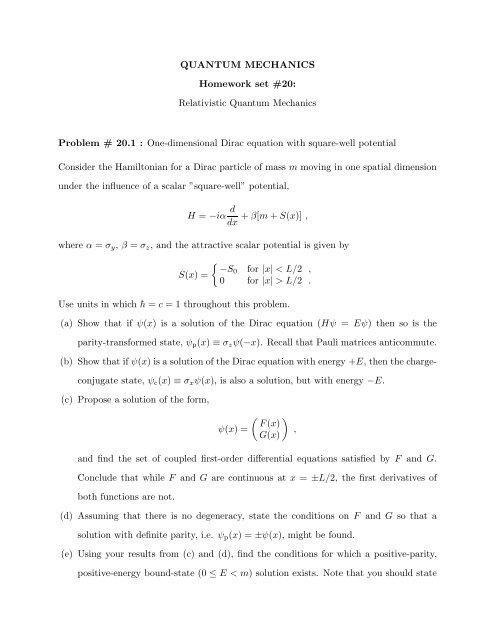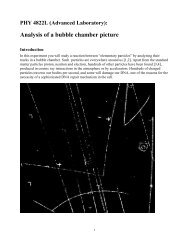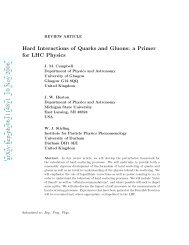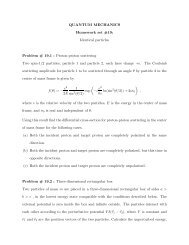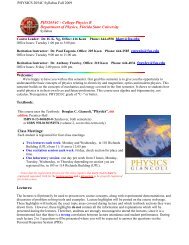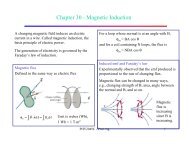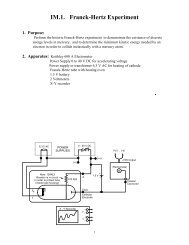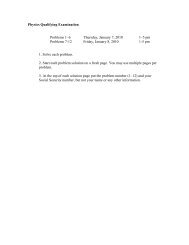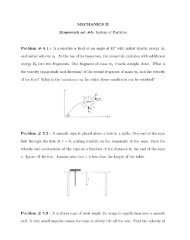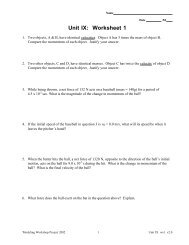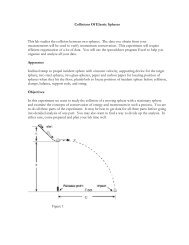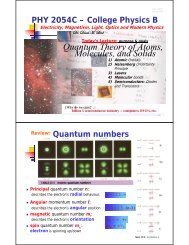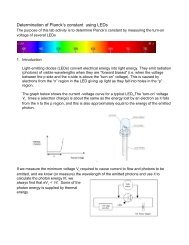QUANTUM MECHANICS Homework set #20: Relativistic Quantum ...
QUANTUM MECHANICS Homework set #20: Relativistic Quantum ...
QUANTUM MECHANICS Homework set #20: Relativistic Quantum ...
- No tags were found...
You also want an ePaper? Increase the reach of your titles
YUMPU automatically turns print PDFs into web optimized ePapers that Google loves.
<strong>QUANTUM</strong> <strong>MECHANICS</strong><strong>Homework</strong> <strong>set</strong> <strong>#20</strong>:<strong>Relativistic</strong> <strong>Quantum</strong> MechanicsProblem # 20.1 : One-dimensional Dirac equation with square-well potentialConsider the Hamiltonian for a Dirac particle of mass m moving in one spatial dimensionunder the influence of a scalar ”square-well” potential,H = −iα d + β[m + S(x)] ,dxwhere α = σ y , β = σ z , and the attractive scalar potential is given byS(x) ={−S0 for |x| L/2 .Use units in which ¯h = c = 1 throughout this problem.(a) Show that if ψ(x) is a solution of the Dirac equation (Hψ = Eψ) then so is theparity-transformed state, ψ p (x) ≡ σ z ψ(−x). Recall that Pauli matrices anticommute.(b) Show that if ψ(x) is a solution of the Dirac equation with energy +E, then the chargeconjugatestate, ψ c (x) ≡ σ x ψ(x), is also a solution, but with energy −E.(c) Propose a solution of the form,ψ(x) =( )F (x)G(x),and find the <strong>set</strong> of coupled first-order differential equations satisfied by F and G.Conclude that while F and G are continuous at x = ±L/2, the first derivatives ofboth functions are not.(d) Assuming that there is no degeneracy, state the conditions on F and G so that asolution with definite parity, i.e. ψ p (x) =±ψ(x), might be found.(e) Using your results from (c) and (d), find the conditions for which a positive-parity,positive-energy bound-state (0 ≤ E
(e) Explain which of the solutions of parts (c) and (d) would be appropriate to describeneutrinos, which are massless particles with negative helicity.Problem # 20.3 : ZitterbewegungConsider a free Dirac particle described bywhere ⃗α =matrices.( )0 ⃗σand β =⃗σ 0(a) Use the Heisenberg picture to establishH = c⃗α · ⃗p + βmc 2 ,( )1 0. The matrices ⃗σ and 1 are the 2 × 2 Pauli and unit0 1ddt ⃗p =0 , ddt ⃗α = 2i¯h (c⃗p − H⃗α) , d⃗r = c⃗α .dt(b) These equations can be integrated to obtain⃗p = ⃗p (0)⃗r = ⃗r (0) + c2 ⃗pH t + ¯hc2iH⃗α = c⃗p [H + e2iHt/¯h ⃗α(0) − c⃗pH{e 2iHt/¯h − 1]} [ ⃗α(0) − c⃗p ]H.Confirm this by differentiating the given results for ⃗p , ⃗α , and ⃗r .(c) The last terms in the result for ⃗α and ⃗r are related to the so-called ”Zitterbewegung”.These make no contribution to 〈⃗α 〉 and 〈⃗r 〉 for wave packets containing solely positiveor negative energy components. Prove this by establishingΛ ±( ⃗pH − ⃗α )Λ ± =0,where Λ ± are the projectors on states with positive and negative energy, respectively,Λ ± = 1 [1 ± H ],2 E pwith E p = √ m 2 c 4 + p 2 c 2 .
Hint: Start by establishing the general result Λ[Λ,O]Λ = 0 for any projection Λ andoperator O, then consider O = ⃗α .Problem # 20.4 : Spin-orbit couplingThe spin-orbit interaction in the hydrogen atom is given by the potentialV so = 1 1 dVS2m 2 c 2 r dr ⃗ · ⃗L ,which is of relativistic origin (i.e. it vanishes as c →∞). Here ⃗ S and ⃗ L are the spin andorbital angular momenta, respectively, and V = −Ze 2 /r is the Coulomb potential.Using the wave-functions for the hydrogen atom as given by the solutions of theSchrödinger equation (non-relativistic hydrogen atom), obtain the spin-orbit coupling constantby calculating the matrix element〈nlm l m s |V so |nlm ′ lm ′ s〉 .Obtain the energies of the hydrogen atom including the spin-orbit coupling and compareyour result to the exact energies (solutions of the Dirac eqn.), given byE nj = − mc22α 2 Z 2 [n 2 1+ α2 Z 2 ( nn 2 j +1/2 − 3 ) ]+ ···4Here α = e 2 /¯hc ≈ 1/137 is the fine-structure constant.Hint: You will need the expectation value〈nl|r −3 |nl〉 =Z3 1a 3 0 n3 l(l +1/2)(l +1) , l ≠0 ,which can be calculated using the method of problem # 8.1 (calculation not required).Here a 0 =¯h 2 /me 2 is the Bohr radius for Z =1..


